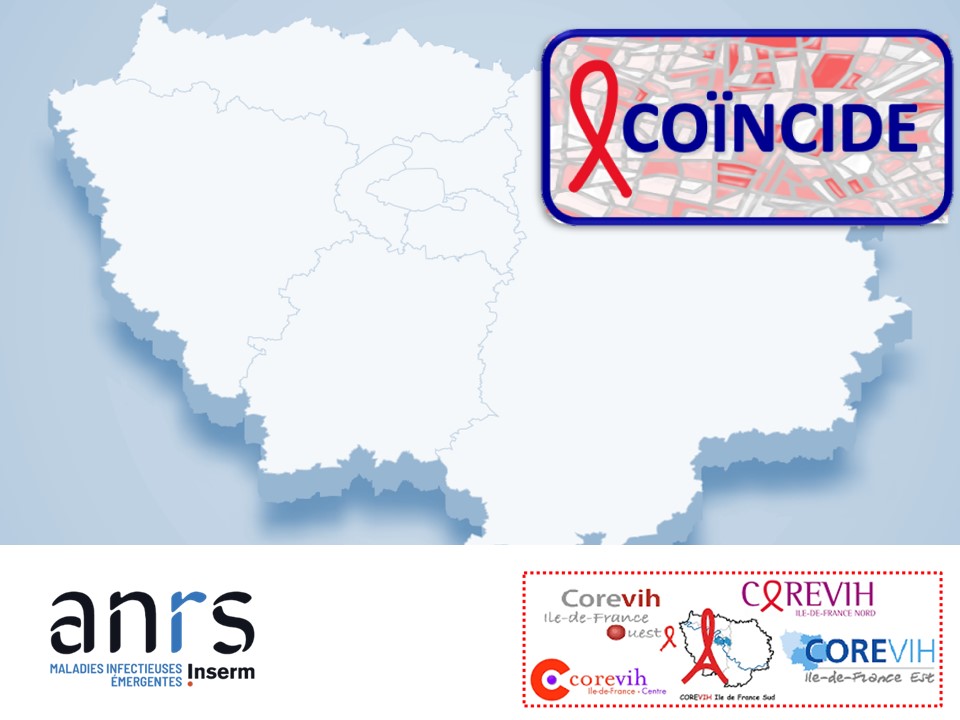
COINCIDE - Infra-departmental maps of new HIV diagnoses in Île-de-France
Mapping the HIV epidemic in the Paris Region
Last updated on 21 January 2025
The COINCIDE study has made it possible to gain a more detailed understanding of the HIV epidemic in the Paris region on a detailed geographical scale, and the Cartoviz tool’s user-friendliness makes it easier to disseminate and use, particularly among those potentially involved in screening and prevention (associations, pharmacists, GPs, CeGIDDs, analysis laboratories, etc.).
In brief
Main Investigator
Fabienne CABY
Pathology
VIH
Teams:
Inserm UMR-S 1136, iPLESP,
Inserm UMR-S 1295
COREVIH IdF, COREVIH Nord, COREVIH Est, COREVIH Sud, COREVIH Centre, COREVIH Ouest
Partners:
ORS-IdF : A Saunal, L Firdion, V Féron
Sponsorship:
COREVIH Ile-de France NORD
COINCIDE study methodology
This study was based on data from newly-diagnosed people living with HIV (PLHIV) only, as they reflect the dynamics of the epidemic, both in terms of numbers and stage of infection at diagnosis. Data were collected by the 52 centres of the five COREVIHs in the Île-de-France region and concerned all adult PLHIV diagnosed between 2014 and 2021, residing in the Île-de-France region and cared for in one of the centres (10,510 PLHIV included in the study). The maps were drawn up in collaboration with the ORS, based on the place of residence of the PLHIV included at the time of diagnosis.
The COINCIDE study results
The COINCIDE study reveals that, although the rates of new diagnoses are highest in Paris, the epidemic dynamics are less favourable outside Paris and particularly in the outer suburbs. Whatever the key population (men who have sex with men (MSM), women, foreign-born non-MSM), late diagnoses are often much more frequent outside Paris, indicating the need to strengthen screening strategies to reach these populations in these areas. What’s more, it is the hardest-to-reach and often most vulnerable populations (women and men born abroad who are not MSM) who predominate in the vast majority of areas outside Paris.
At the same time, screening rates are much lower outside Paris, and potential access to general practitioners is much lower.
The sub-departmental scale thus reveals very marked territorial and population disparities across the region, and identifies ‘key areas’ that should be given priority for controlling the epidemic, even in the outer suburbs: those where the rates and numbers of new diagnoses are high, indicating an active epidemic, and those where late diagnoses are frequent, indicating that key populations are not being reached, or are only being reached to a limited extent, by current screening strategies.
These maps are an invaluable aid in rethinking screening and prevention strategies, which need to be adapted not only to ‘key populations’ but also to specific regional epidemics, which until now have received little attention because of data shortages.
Latest news about the study
The maps and the Cartoviz tool were presented at the ‘Fast-Track-Cities’ conference in October 2024:
- ‘Mapping of new diagnoses in Paris Area: The Cartoviz tool from the COINCIDE study’, CABY Fabienne et al.
Two studies based on COINCIDE data were presented at the SFLS in November 2024:
- ’ Socio-territorial inequalities in late HIV diagnoses in Ile-de-France ’, ROJAS-CHAVES Alejandro et al.
- ’ PLWHA living in the suburbs and receiving care in Paris ’, ROJAS-CHAVES Alejandro et al.
Go to the Cartovitz COINCIDE application
This Cartoviz presents new indicators from the study on the state of the HIV epidemic in the Paris region.
Cartovitz